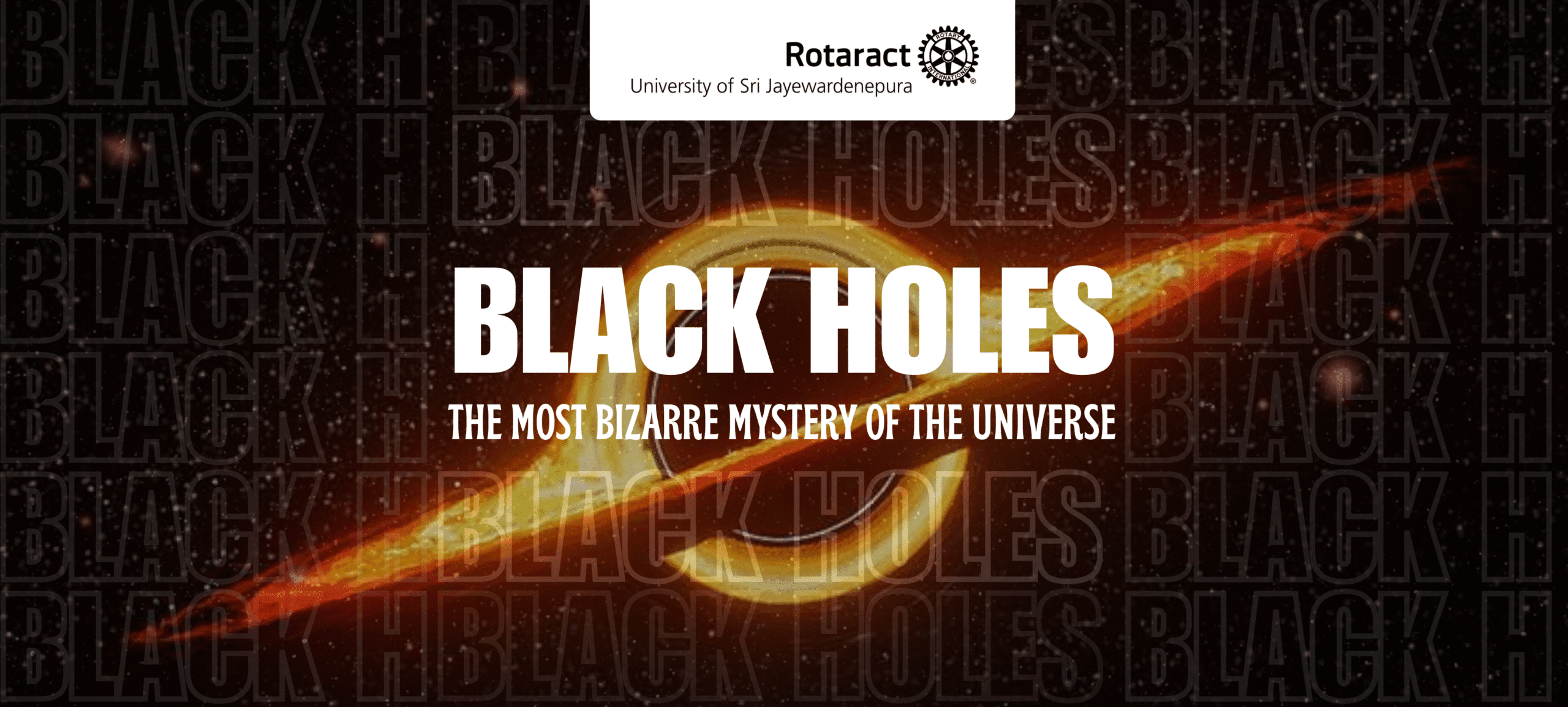Written by: Rtr. Buthma Menali
Have you heard of the Bermuda Triangle? No one knows what will happen once you are in there. Just like the black holes! Just the name says they are among the strangest, most extreme phenomena in the universe, so bizarre that the laws of physics seem to unravel at their edges.
So, what exactly are black holes? Where do they come from, and what happens if you fall into one?
To begin, we can simply define black holes as regions in space that pack an enormous amount of mass into a tiny volume. That’s why the gravitational force here is so strong that not even light can escape! So now you know why this is black.
Do you know how these are actually created? Let’s start at the beginning, with stars.
The death of a giant
Stars are not eternal. They are massive collections of mostly hydrogen atoms that collapsed under their own gravity. Deep inside the stars, something miraculous happens! The hydrogen atoms fuse into helium, releasing a huge amount of energy. This is known as nuclear fusion. And this energy is the source that keeps the stars from collapsing under their own gravity by pushing outward. This is a delicate tug-of-war that helps the star to burn for millions to billions of years.
Massive stars which are many times larger than our sun burn their fuel much faster and more violently. As they run out of hydrogen, they start fusing heavier elements such as carbon, oxygen, silicon, etc., until they reach iron at the core of the star. And that’s where the trouble begins!
Fusing iron doesn’t release energy; it consumes it. With no more outward force to resist gravity, the core of the star catastrophically collapses in a fraction of a second. Matter rushes inward at a quarter of the speed of light, and the result is a dramatic explosion known as a supernova explosion.
From the ashes, two possibilities are born. One thing is a neutron star, and the other thing is this so-called black hole! If the star was massive enough, gravity wins entirely, and the core collapses into something so dense and so compact that not even light can escape it!
There can be other methods or processes of being born of a black hole which are still unknown in the known science.
Singularities and the Death of Logic
But if the event horizon is the black part, what is the “hole” part of the black hole? The singularity.
At the very centre of a black hole lies something called a singularity. It’s a point where all the mass of the black hole is crammed into a space of zero volume. This is a place where the known laws of physics break down. We don’t really know what a singularity is. It could either be an infinitely dense point or something far more exotic.
But the most unexpected thing is black holes don’t suck things up like a vacuum cleaner! If our sun were to suddenly turn into a black hole of the same mass, nothing much would change for Earth, except that we would freeze to death, of course.
Falling In: A One-Way Trip
Let’s say, for argument’s sake, you fell into a black hole. What would happen?
From an outside perspective, as you approach the event horizon, you’d seem to move slower and slower, eventually freezing in time, turning red, and fading from view. More like disappearing. But for you, the experience would be very different.
Time would speed up around you. So, it looks to you like the universe is speeding up. Galaxies might swirl and fade, and stars could explode and die, all in what feels like seconds. This is because the black holes are distorting space and time near them.
But then… comes the pain.
As you get closer to the singularity, gravity stretches you more at your feet than at your head. The difference in force becomes so extreme that you’d be pulled apart atom by atom, a process known as spaghettification. Yes, that’s a real word, and it’s not a fun trip.
Another way of thinking about it is just that the distortion in spacetime is not constant over the length of your body. It’s not only stretching; it’s also squashing. You start to feel this strange sensation of being stretched and squashed. And as you go closer and closer to the singularity, those effects become much more extreme until it is so extreme that, first of all, you cease to stay together. We’re one long string of atoms.
First, your body is pulled apart into atoms. Then those atoms are torn into subatomic particles: protons, neutrons, and electrons. Even the quarks inside the protons eventually get ripped apart. Every bit of you races inward, toward the singularity.
Now, it’s tempting to imagine the singularity as a point, an infinitely dense place where the collapsing star was crushed. But a black hole isn’t just a thing in space. It’s a distortion of spacetime itself. So, the singularity isn’t only a place. It’s also a moment, the end of time, at least according to Einstein’s theory of general relativity.
The mass of the black hole determines your fate. Smaller ones kill you faster. But supermassive black holes — the kind that sit at the centre of galaxies — are a different story. You might even cross their event horizon without noticing… for a while.
Different Sizes of Black Holes
Black holes come in many sizes. One of the smallest black holes ever discovered is J1650. Its diameter is only about as long as Manhattan, yet it holds a mass 3.8 times that of our sun. Then there’s Phoenix A, which is the largest known black hole. This has a mass of 100 billion suns!
Somewhere out there, even more massive black holes could be waiting to be discovered.
The End? Or Just the Beginning?
Black holes don’t last forever. Thanks to Hawking radiation, black holes eventually evaporate and fade over time, slowly emitting energy and losing mass. But this process takes longer than the age of the universe. Some may take a googol years to disappear! So you might not see the birth and death of the same black hole in your lifetime!
A Cosmic Paradox
Black holes are riddles written in the language of gravity and light. They push the boundaries of science, challenge our understanding of reality, and invite us to imagine the unimaginable. They are not just ends; they are beginnings. They force us to ask the most profound questions of all.
What is space? What is time? And what lies beyond the edge of knowledge?
Maybe, just maybe, the answers are hiding in the shadows. Science is the truth, until the truth is discovered!


Good work!! Looking forward to reading more of your work!! ☺️
Thank youu! 🥰